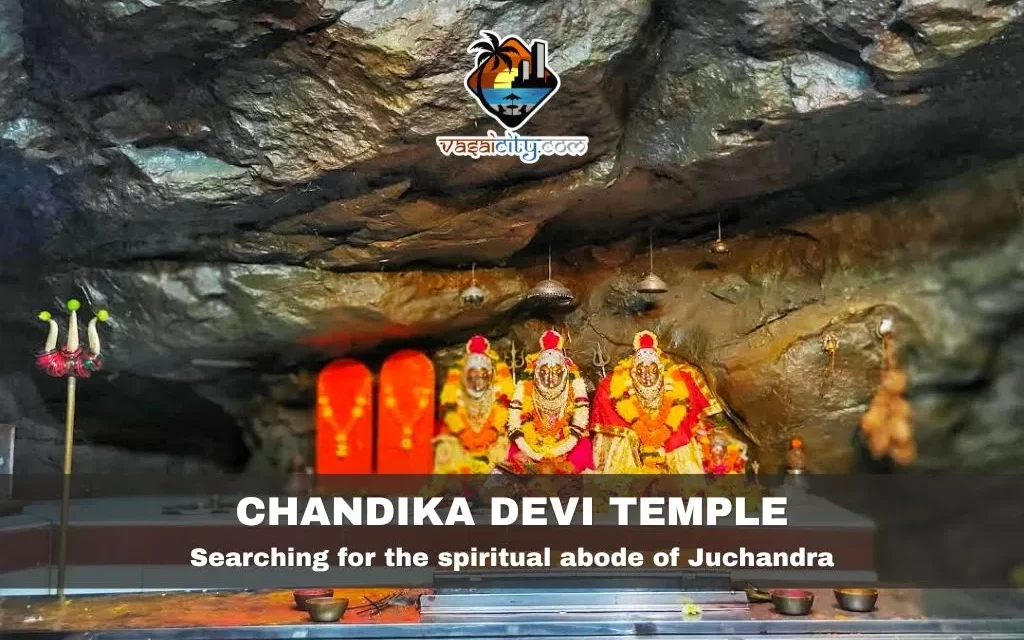Introduction
Nestled amidst the serene landscape of Juchandra, a quaint town in the heart of India, lies the iconic Chandika Devi Temple. In addition to being an architectural masterpiece, this temple is a spiritual paradise that attracts tourists and followers from all over the world. For those seeking spiritual peace and a closer relationship with their inner selves, this place is a must-visit because of the calm environment, interesting celebrations and heavenly presence of Goddess Chandika.
Table of Contents
Historical Significance
Chandika Devi Temple has a rich historical background dating back centuries. Legends tell that the temple was built in the 8th century during the reign of the Silahara dynasty. The temple has undergone numerous changes and reconstructions throughout the years, yet it has managed to maintain its authenticity and charm from the past.
The roots of the temple are deeply associated with Goddess Chandika, who is an incarnation of Goddess Durga – the supreme female deity of strength and protection. Devotees believe that visiting the temple and worshiping Chandika Devi can bring blessings and reduce troubles and hardships.
Architectural Marvel
The architecture of Chandika Devi Temple is a splendid amalgamation of ancient Hindu design elements and modern structural expertise. The exterior of the temple has intricate carvings and sculptures, depicting mythological stories and epic tales. As soon as you step inside, the main sanctum welcomes you with an awe-inspiring idol of Chandika Devi adorned with colorful flowers and glittering ornaments.
The serene atmosphere of the temple is further enhanced by the melodious chants and bells ringing during various rituals. The conch’s booming sound creates an outstanding music that vibrates in the devotees’ hearts and souls.
Spiritual Practices and Rituals
Chandika Devi Temple is a place where spirituality and devotion merge harmoniously. Dedicated followers swarm the temple every day to offer prayers, seek blessings, and take part in religious ceremonies.
A typical day at the temple begins with the rhythmic chanting of Vedic mantras during the morning aarti. Devotees gather in large numbers to witness this spiritual spectacle and feel refreshed by the positive energy that fills the air. As the day progresses, various worship ceremonies are conducted by the temple priests, where devotees can actively participate in the rituals.
Navratri festival is celebrated with great enthusiasm in Chandika Devi Temple. During this nine-day festival, the temple is decorated with dazzling lights & colorful decorations. Devotees come from far and wide to worship the Goddess and seek her divine blessings.
Connect with Nature
Beyond its religious significance, Chandika Devi Temple offers a unique opportunity to connect with nature and explore the natural beauty of Juchandra. On top of a hill, the temple is surrounded by dense greenery and offers breathtaking views of the surrounding landscape. Tourists often take a leisurely stroll around the temple premises, enjoying the serene atmosphere and fresh air.
The place on top of the hill also gives a breathtaking view of sunrise and sunset. Many tourists throng the temple in the early morning or evening to watch the mesmerizing colors in the sky, creating an experience that transcends the physical world and touches the soul.
Community Impact
Chandika Devi Temple plays an important role in the local community. Apart from being a religious place, the temple also serves as a center of cultural and social activities. Various festivals and events are organized in the temple, thereby promoting a sense of unity and harmony among the residents of Juchandra.
The temple management is actively engaged in philanthropic activities, helping the underprivileged through donations, medical camps and educational initiatives. This compassionate approach of the temple towards the community has earned it immense respect and appreciation.
Conclusion
The Chandika Devi Temple at Juchandra is not just a place of worship, but a spiritual sanctuary that nourishes the mind, body and soul. Its historical significance, architectural beauty and connection with nature make it an exceptional destination for those seeking peace and divine blessings.
Whether you are a devoted pilgrim or an avid traveler, a visit to Chandika Devi Temple promises an experience of a lifetime. As soon as you step into this holy abode, you will undoubtedly feel the presence of a higher power, which will fill you with a sense of peace and spiritual bliss. So, plan your trip to Juchandra and get immersed in the divine aura of Chandika Devi Temple.
Frequently Asked Questions
-
Where is the Chandika Devi Temple located?
The Chandika Devi Temple is located in the town of Juchandra, in the heart of India.
-
What is the historical significance of the temple?
The temple dates back to the 8th century and was constructed during the reign of the Silhara dynasty. It is dedicated to Goddess Chandika, an incarnation of Goddess Durga, and is believed to bestow blessings and protection upon devotees.
-
What can visitors expect to see in terms of architecture?
The temple showcases a splendid mix of ancient Hindu design elements and modern architectural expertise. The exterior features intricate carvings and sculptures depicting mythological stories. Inside, the main sanctum houses a beautiful idol of Chandika Devi, adorned with flowers and jewelry.
-
What spiritual practices and rituals take place at the Chandika Devi Temple?
The temple conducts daily rituals, including morning and evening aartis (prayer ceremonies) with Vedic chanting. Devotees can actively participate in various puja ceremonies performed by the temple priests. The Navaratri festival is also celebrated with great enthusiasm at the temple.
-
How does the temple connect with nature?
The Chandika Devi Temple is situated on a hilltop, surrounded by lush greenery and offers panoramic views of the picturesque landscape. Visitors can enjoy nature walks and experience breathtaking sunrises and sunsets from the hilltop.
-
What impact does the temple have on the local community?
Apart from being a religious landmark, the temple serves as a center for cultural and social activities. It hosts festivals and events that bring the community together. Additionally, the temple engages in philanthropic activities, supporting the underprivileged through donations and various initiatives.
-
Can non-devotees visit the Chandika Devi Temple?
Yes, the temple warmly welcomes all visitors, irrespective of their faith. People from different walks of life visit the temple to explore its architectural beauty and experience its serene ambiance.
-
Is there any specific time to visit the temple?
The temple is open to visitors throughout the year. However, if you wish to experience the vibrant celebrations of Navaratri, planning your visit during this nine-day festival would be ideal.
-
How can one reach Juchandra and the Chandika Devi Temple?
Juchandra is well-connected by road and rail. Visitors can reach the town via local trains or private vehicles. From there, the temple can be accessed through a short trek or by availing local transportation.
-
What should visitors keep in mind while visiting the temple?
While visiting the Chandika Devi Temple, it is essential to respect the customs and traditions. Dress modestly, remove footwear before entering the sanctum, and maintain a peaceful demeanor to ensure a harmonious experience for all.
-
Can visitors take photographs inside the temple?
Photography rules may vary, so it’s advisable to inquire with the temple authorities before taking any pictures inside the temple premises.
-
Are there any accommodation options near the temple?
Juchandra offers limited accommodation options. For more choices, visitors can consider staying in nearby towns or cities and plan a day trip to the temple.
-
Can visitors participate in the temple’s charitable activities?
Yes, the temple management often welcomes volunteers and contributions for their philanthropic initiatives. If interested, visitors can inquire with the temple authorities about ways to contribute.
-
Is the Chandika Devi Temple accessible to differently-abled individuals?
The temple may have some accessibility challenges for differently-abled individuals due to its hilltop location. However, with assistance, most parts of the temple can be accessed.
-
What sets the Chandika Devi Temple apart from other temples in the region?
The unique blend of history, architecture, and connection with nature sets the Chandika Devi Temple apart. Its philanthropic endeavors and active community engagement make it a spiritually enriching and socially impactful destination.
-
Is there any special significance of visiting the temple during Navaratri?
Navaratri holds immense significance at the Chandika Devi Temple as it marks the celebration of the divine feminine energy. During this festive period, the temple is adorned with colorful decorations, and various cultural events take place. The atmosphere is charged with devotion and spiritual fervor, making it an opportune time to experience the true essence of the Goddess Chandika.
-
Can visitors participate in the morning and evening aartis?
Yes, visitors are welcome to join the morning and evening aartis. The melodious chanting of Vedic mantras and the mesmerizing aura of the aartis create a profound spiritual experience for everyone present.
-
Are there any local attractions nearby that visitors can explore?
Juchandra is surrounded by natural beauty and offers some other attractions nearby. Visitors can explore nearby hills, lakes, and serene spots for picnics and nature walks. Additionally, the ancient caves and historical sites in the region provide insights into the area’s rich heritage.
-
Can visitors receive blessings from the temple priests?
Absolutely! The temple priests are approachable and are more than happy to bless visitors seeking divine blessings. They often perform individual blessings during specific puja ceremonies.
-
Is there a dress code to be followed while visiting the temple?
While there is no strict dress code, it is advised to dress modestly and respectfully while visiting the temple, as it is a place of worship. Wearing traditional attire is considered appropriate.
-
Can visitors bring offerings to the Goddess?
Yes, visitors can bring offerings such as flowers, fruits, coconuts, or other items to offer to the Goddess during their prayers and rituals. It is a gesture of devotion and reverence.
-
Can visitors receive any sacred items or prasad from the temple?
Yes, devotees are often given prasad, which is a sacred offering blessed by the Goddess. It is considered to bring luck and positive energy.
-
Are there any special rituals performed on specific days of the week or month?
While the temple performs daily rituals, certain days of the week or auspicious occasions may witness special ceremonies and celebrations. Visitors can inquire with the temple authorities for information about such events.
-
Can visitors light diyas or candles inside the temple premises?
The lighting of diyas or candles inside the temple premises may be subject to specific rules and regulations. It is advisable to seek permission from the temple authorities before doing so.
-
How can visitors contribute to the maintenance of the temple?
Visitors can contribute to the maintenance and upkeep of the temple through donations or by actively participating in the temple’s charitable initiatives. Volunteering time and resources are also appreciated by the temple management.
-
Is the temple accessible during all seasons?
Yes, the Chandika Devi Temple remains accessible during all seasons. However, visitors may want to consider weather conditions, especially during monsoons, as the hilltop location may be slippery.
-
Can visitors get a glimpse of the temple’s history and artifacts?
The temple’s history and artifacts may be showcased in a museum or a designated area within the temple complex. Visitors can explore these exhibits to learn more about the temple’s heritage.
-
Can visitors meditate or practice yoga within the temple premises?
The serene ambiance of the temple makes it an ideal place for meditation and contemplation. Visitors can find a quiet spot within the temple premises to meditate or practice yoga in harmony with nature.
-
What makes a visit to the Chandika Devi Temple a memorable experience?
What makes a visit to the Chandika Devi Temple a memorable experience?








